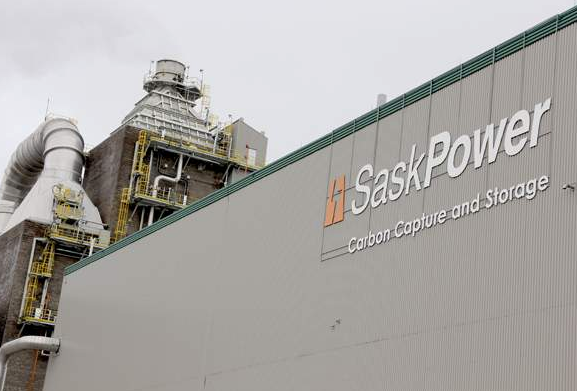The whole point behind the carbon capture project at Boundary Dam Power Station was to cut pollution. While nobody is disputing the project, which opened on Oct. 2, is reducing polluting emissions and will continue to do so, there are some suggesting the $1.4 billion project in Estevan doesn’t cut it.
Critics of the investment in what is dubbed “clean coal” suggest spending $1.4 billion on renewable, zero-emission energy would be a better place for those taxpayer dollars. Premier Brad Wall said during the grand opening that the province’s energy eggs don’t need to be in one environmentally friendly basket, and carbon capture has a role to play.
“It’s not an either/or proposition,” Wall said bluntly, “because what the Sierra Club is forgetting is that the statistics are pretty clear: There are 1,200 coal plants going to be built around the world. India’s using coal. China’s using coal. They’re building new plants all over the world. We need to invest in renewables, but we better also invest in technologies that can clean up coal.”
Wall acknowledged that burning coal is the single biggest contributor of damaging emissions around the planet.
“The number one challenge we have to deal with in the world is not the oilsands. In fact, the statistics prove it, it’s not oil and gas, it’s coal. It’s coal in China. It’s coal in India. It’s coal in these developing countries and in North America and Europe and Japan,” said the premier.
A Pembina Institute report in 2012 noted coal power plants accounted for seven of the top ten polluters in Canada. That report said Boundary Dam Power Station was the seventh largest contributor of greenhouse gas emissions in the country.
To just about everyone, it’s clear what the problem is. What’s unclear is the best solution. The carbon capture project is Saskatchewan’s biggest attempt at a solution yet. The project comes as the province’s reliance on coal for power continues to fall. Ten years ago the resource, which has been mined heavily in the Estevan area for years, accounted for 65 per cent of Saskatchewan’s power. Today, it provides only 47 per cent of that power.
“We — the world — we better get our head around trying to clean it up, and that’s exactly what Boundary Dam 3 proves we can do. Clean coal is not an oxymoron,” said Wall.
Mike Monea, SaskPower president of carbon capture and storage initiatives, considers the project a success after the switch was flipped and everything was working. The carbon is being captured.
“We’ve got some wrinkles that we need to iron out, but it’s capturing beautifully,” said Monea.
The captured carbon is reportedly very pure. At 99.9 per cent purity, the captured product is what both SaskPower and Cenovus Energy, who is buying the CO2, were hoping for.
“We hoped it would be in the 98 per cent range, but the plant’s really operating at a high, high level.”
Though the captured carbon is pure, the facility isn’t capturing the promised 90 per cent of emissions at the moment.
“We’re not capturing 90 per cent of the CO2 yet. We have some strainers to take off the turbine in order to have it run at 100 per cent, but we’ll be capturing at our target levels at a high purity,” said Monea.
Concerns over what happens with the carbon once it is captured, sold to oil companies for enhanced oil recovery and injected into the ground, were put to Wall and Monea, who both attempted to put fears of ground contamination to rest.
“We have over a decade of experience with geologically storing CO2 in Saskatchewan,” Wall said.
“The oilfields have been around for 150 million years, and no oil has ever leaked to the surface that I know of,” said Monea about the proposed infallibility of storing carbon in a porous layer of rock kilometres beneath the ground. “There are reservoirs that have oil and because the oil is there, there is an entrapment, there is a process that keeps the oil in place. CO2 will remove oil and then it’s recycled and put back in the ground. It will be trapped for thousands of years.”
He said they have monitoring systems that detect leaks. Federal regulation states if any leakage is detected in the basin, the well has to be cemented and properly abandoned.
“I think there is a great body of overall research into CO2. The International Energy Agency … they’ve been monitoring our storage here in Saskatchewan for years, and they’ve basically confirmed it’s an efficacious way to deal with CO2,” Wall said.
“Nobody has built a commercial plant like this. When you build a major, large commercial plant, that’s when you see the performance data, and then we can see what the emission rates are, and they are going to be low,” said Monea. “The CO2 is probably going to be two, two and a half times cleaner than natural gas plants, and we have a lot of natural gas plants.”
And while the project from the get go promised the capture process would remove 90 per cent of carbon dioxide emissions from the air, that’s not what it’s doing yet.
“We have a shutdown in one week in order to remove strainers from our turbine, and then once that happens, we can ramp up our turbine to 100 per cent.”
At that time, Monea said they expect to begin capturing 90 per cent of the carbon dioxide that would otherwise be emitted into the environment.
“We have a few workarounds that we need to do on some design issues on our capture plant that we need to fix — this is the first time we’ve got this thing running — so we need to get that modified also. But we’ll be at 90 per cent capture (of CO2) and 100 per cent of the sulphur dioxide,” said Monea.




